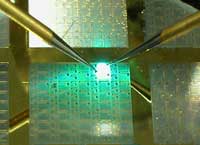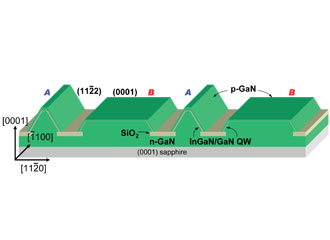Web Japan > Trends in Japan > Sci-tech > Broadening The Led Color Spectrum
Broadening The Led Color Spectrum
New Diode Can Produce White and Intermediate Colors

This LED is capable of producing white light and a variety of colors. ©Department of Electronic Science and Engineering, Kyoto University
Kyoto University and Nichia Corp., which is known for its light-emitting diodes, announced in January 2008 that they had successfully developed a revolutionary LED capable of emitting a variety of colors of light, including white and intermediate colors. The breakthrough was announced in Applied Physics Express (APEX), an English-language scientific magazine published in Japan.
How the LED Works
The LED combines a P-type semiconductor, which has many electron holes (parts that lack an electron), with an N-type semiconductor, which has many electrons. Light is produced on the surface where the two semiconductors are joined together when enough voltage is applied. LEDs have several advantages over the traditional light sources of incandescent and fluorescent light bulbs. The first is durability, with an LED lasting dozens of times longer than an incandescent bulb. An LED also uses only a fraction of the electricity needed to power an incandescent bulb. On top of that, LEDs produce little heat and light up as soon as an electric current is applied. These merits have led to the increasing use of LEDs as pilot lamps in electric appliances, which are used to display the operational status of the machine, and in traffic lights and street illumination.
However, there had always been an issue with using LEDs to produce colors. Because the semiconductor device itself is what glows, the color produced is determined by the materials used to make the semiconductor. The search began in the 1980s for materials that could produce the desired colors, and by the 1990s, the three primary colors for light—red, blue, and green—had been produced. Other LEDs were developed that could produce orange, yellow, and purple light. It proved difficult, however, to produce intermediate colors.
What is more, as no material had been discovered that could produce white light, white was only obtainable via one of three methods: (1) by simultaneously lighting up three LEDs that produce the primary colors of red, blue, and green at different strengths; (2) by simultaneously lighting up two LEDs that produce complementary colors, such as blue and yellow or green and red; or (3) by enveloping a blue LED in a special fluorescent substance. Each of these three methods has flaws, however. In the first two, it is difficult to adjust the strength of each of the LEDs involved, and in the third, a great deal of energy is lost through the fluorescent substance.

Two types of LEDs, one that has a high, narrow bank, and another that has a low, wide bank. ©Department of Electronic Science and Engineering, Kyoto University
An Epochal Development
The LED created by Kyoto University and Nichia Corp. cuts through these problems. The semiconductor’s basal plate is made from thin sapphire crystal, and on top of that is placed gallium nitride that has been crystallized in the shape of a symmetrical river bank. LEDs have so far had only one side, which is flat, and so can thus produce only one color. This new LED, however, emits two different colors of light, combining the color from the top of the bank structure with the one from the side.
The research team has created two types of LEDs, one that has a high, narrow bank, and another that has a low, wide bank. The LED with the high, narrow bank emits red light from the top of the bank and blue from the side. The LED with the low, wide bank emits yellow from the top and blue from the side. By changing the ratio and position of the two different structures of LEDs, red, blue, and yellow light can be produced and combined in various ways, making it possible to produce white light and intermediate colors.
As there is no need to use a fluorescent substance, this groundbreaking LED is highly energy efficient. If the LEDs can be commercialized, they are likely to spark growth in the market for white-light LEDs. The diodes are expected to be used in situations where a very precise combination of light color is needed, such as the lighting used for surgical procedures and the background lighting for photography. (August, 2008)

